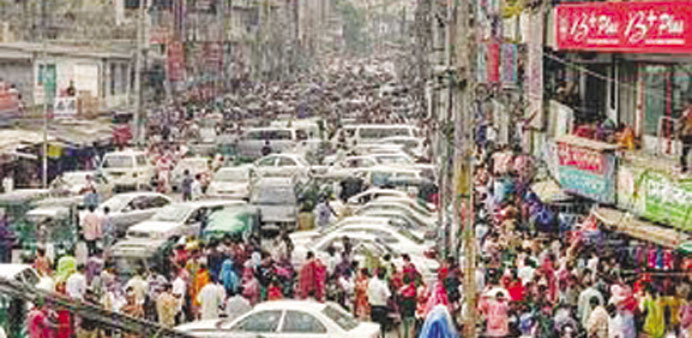Dhaka ranks as the least livable city among 140 cities surveyed by the Economist Intelligence Unit based on 30 factors.
IANS/Dhaka
Dhaka has grown so crowded that existing infrastructure makes it almost impossible for many to lead a comfortable life in the capital city with population density of about 43,000 people per sq km.
Dhaka, covering about 350sq km, is now home to over 15mn people.
Population boom coupled with unplanned industrialisation and urbanisation spoiled the urban vegetation of Dhaka, triggering urban problems such as pollution, congestion, and inadequate public services.
There is a huge gap between the growing population and facilities like transport, over-bridges, underpasses, flyovers, bus stops and footpaths in the city.
Pedestrians often find many footpaths almost impassable because they are mostly occupied by hawkers or roadside businesses, says a Xinhua report.
“I feel very sick when I walk in the city streets. I can’t imagine that a city might have such a huge crowd,” said Sajjad Sumon, a fresh university graduate who has recently come to Dhaka from the southeastern port city of Chittagong to look for a job.
Sumon expressed his concern over Dhaka’s future seeing such a dense population throughout the city.
Experts say Bangladesh’s centralised economic policy is the key reason for continual population growth in Dhaka, which witnesses a massive influx of rural people seeking to escape hunger, poverty and insecurity.
They say hundreds of brick kilns on the fringes of the city also contribute to the air pollution and
withering trees.
“This is the fastest growing megacity in the world. But at the same time, this is the most unlivable city as well,” said Nurun Nabi, a professor of population sciences at Dhaka University.
Recently, Dhaka has been ranked as the least livable city among 140 cities surveyed by the Economist Intelligence Unit based on 30 factors, across five categories - stability, healthcare, culture and environment, education and infrastructure.
He said: “Our land size is the main constraint. A small growth of population contributes a huge stress for the country.”
“Our national population growth rate is currently 1.37%, rate of internal movement throughout the country is 4.5%, and the rate of migration to Dhaka is 6% which is unimaginable. Overwhelming majority of migrated people is poor,” Nabi said.
Nabi said inadequate facilities in Dhaka result in many environmental health hazards.
Dhaka within a decade will face a grim situation unless the country develops new cities with adequate facilities to accommodate increasing influx of people from across the nation, he added.
Nabi points out that poverty in rural areas is the main factor in driving the mass migration to urban centres.
“I have come to Dhaka for business purpose. I think I can make my life better in Dhaka,” said Mohammad Babul who came to the capital only two months ago from his rural village, some 101km southwest of Dhaka, where he used to be a sharecropper.
He said: “Dhaka is a bit expensive for living. But the income is also better than any other places.”
According to Nabi, every year around 1.8 to 2mn people are adding to the total population. “But we cannot build up our infrastructure to meet demand.”
Abdul Kuddus, a Dhaka University student, is living with four others in a tiny dormitory which can hardly accommodate two persons as the country’s top educational institute suffers from shortage of facilities like classrooms, laboratories and dormitories.
“Every student has a dream to study in the best institute of the country. I’m no exception.”
“If there was university or institute like Dhaka University in my home district Chuadanga, some 215km west of Dhaka, I might have not come to Dhaka for my study purpose,” he added.

